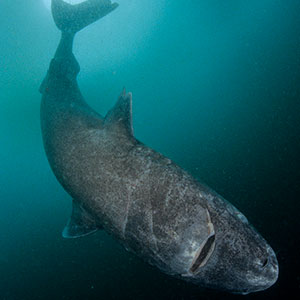Origins of the Greenland shark (Somniosus microcephalus): Impacts of ice-olation and introgression, Walter et al. 2017
by: Veronica DeFelice
Evidence suggests that Greenland sharks are among the oldest vertebrates on earth with some estimates dating individual ages back to the arrival of the first pilgrims in what is now Provincetown Massachusetts some 400 years ago. These sharks can grow up to 5 meters in length, can take up to 150 years to reach sexual maturity and love to bask in near freezing Arctic and sub-Arctic oceanic waters. These deep-sea, slow moving predators appear to be carved from ancient stone and have a diet for marine mammals such as seals and even polar bears.
Previous surveys of this species have shown it to be genetically distinguishable from other somniosid shark species, including its sister species Pacific Sleeper shark, that is morphologically very similar, but mostly inhabits cool water of the Pacific and the Southern Oceans. Although the two species can be genetically distinguished, recent work from an international consortium of researchers shows that the two have also likely hybridized considerably since they split from a common ancestor some 1-2.34 Mya. Using genetic data and coalescent modeling techniques, researchers reconstructed the probable genetic history and makeup of the two species showing that the initial split and subsequent hybridization between them is likely related to fluctuating sea-levels prevalent during glacial oscillations. From the late Miocene into the Quaternary, massive ice-shelf formation during glacial maxima periodically isolated and fragmented the pan-oceanic somniosid ancestor’s population into an Arctic Basin resident and another more transient population associated with the Arctic’s marginal seas. Periodic isolation (likely lasting between 50-100K years) and reconnection among the populations linked to sea-level fluctuations driven by glacial oscillation most likely allowed periodic genetic isolation and then hybridization among the closely-related sister species.
“So, because this is isolation and hybridization between two species likely driven by the periodic (and cyclical) formation of extensive ice sheets we decided to coin the term “Ice-olation,” Says Denis Roy, an evolutionary and conservation ecologist associated with the Department of Natural Resources and the Environment at the University of Connecticut, and co-author of the recent work appearing in the latest issue of Ecology and Evolution. Perhaps the more interesting and worrying aspect of this work, however, is that it adds to a growing list of recent studies showing the potential for increased hybridization and speciation reversals in light of increasing ecosystem changes world-wide. Here we have a long-lived ancient species with a fairly high propensity to hybridize as climate fluctuates. Perhaps this is a precursor and potential outcome for many closely related species in light of climate change, especially considering most have much shorter lifespans and much more recent evolutionary origins than this relict from the deep.